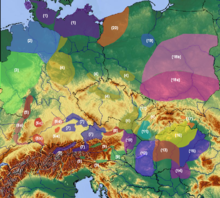Wieselburg culture
|
||||||||
| expansion | ||||||||
|---|---|---|---|---|---|---|---|---|
|
||||||||
| Leitforms | ||||||||
|
The Wieselburg culture is an early Bronze Age culture that emerged from the Leithaprodersdorf group or, in its beginnings, possibly also existed parallel to the Leithaprodersdorf group. The naming of this cultural group goes back to Oswald Menghin and refers to the western Hungarian Moson County (German: Wieselburg). The end of the Wieselburger culture is around 1,600 BC. In the time from the transition from the Early Bronze Age to the Middle Bronze Age / Tumulus Age . In Hungarian it is called the Gata culture, after the place Gattendorf in Burgenland .
Distribution area
The core area of Wieselburg culture is located between the Vienna Woods , Danube and Raab as well as in the area of Lake Neusiedl , northern Burgenland and southwest Slovakia. The settlements documented by ceramic finds include: Fischamend , Mannersdorf am Leithagebirge, Schwechat , Sommerein (all in Lower Austria ), Leithaprodersdorf , Parndorf and the Föllik in Burgenland . The settlement on Föllik-Berg is of particular importance, as it is probably a hilltop settlement fortified with ramparts , palisades and moats . Outside this area there are traces of the Wieselburger culture in Stillfried ( Aunjetitz culture ) on Buhuberg and in Mikulov ( Věteřov culture ).
Craft and cultural technology
The bearers of the Wieselburg culture adorned the head, ears, neck, chest and arms with work pieces made of stone, amber, snail shells, glass and metals (silver, gold, copper, bronze). Needles of various shapes made of copper, bronze or animal bones held clothes together. Grave finds (vessels that can be assigned to the Aunjetitz culture, the Mad'arovce culture and the Hungarian North Pannonian culture ) in the necropolis of Hainburg-Teichtal suggest that representatives of the Wieselburger culture already engaged in (barter) trade with neighboring cultures.
Funnel neck cups and double-handled jugs are typical clay vessels. The latter were decorated with plastic covers ("W" -shaped, cross, spider-, snake-shaped). Other clay pots are preferably decorated with incised decorations.
Finds of bronze daggers in Gattendorf, Oggau, Wulkaprodersdorf and Hainburg-Teichtal or of stick daggers at some sites prove the ability of representatives of this culture in metalworking. A special feature that can be assigned to this culture is a find of silver jewelry in Hainburg-Teichtal, which is probably unique for the central Danube region .
The clearly identifiable domestic animals include horses and dogs , although sheep, goats, pigs and cattle are also to be assumed as livestock.
Funeral rites
Individual graves with bodies buried in humps position were common. Contrary to the relatively strictly gender-specific burials of simultaneous, neighboring cultures (e.g. Unterwölblinger Group ) or the forerunner culture ( Leithaprodersdorf group) with north-south orientation of the deceased, the dead were now in south-west - (= head) / north -East - (= feet) direction buried. Men mainly facing west, women facing east, but also men facing east, and women facing north-east and facing west. In some graves there were also traces that indicate the use of (tree) coffins. As grave goods there are clay pots that were placed around the upper body or by the feet. In the latest phase of the Wieselburger culture, at the turn of the Middle Bronze Age, graves can be found without ceramics, but with a corresponding bronze inventory.
Important sources
- Föllik (mountain in Burgenland) near Großhöflein
- Gattendorf (Burgenland)
- Göttlesbrunn
- Hainburg / Teichtal
- Hofmannshöhle near Bad Fischau
- Jois
- Moson County (Wieselburg) in Hungary
- Mannersdorf am Leithagebirge
- Oggau
- Rusovce / Slovakia
- Wulkaprodersdorf
literature
- Johannes-Wolfgang Neugebauer : Bronze Age in Eastern Austria (= Scientific publication series Lower Austria. 98/101). Verlag Niederösterreichisches Pressehaus, St. Pölten / Vienna 1994, ISBN 3-85326-004-7 .
- Ernst Probst : Austria in the Early Bronze Age. GRIN-Verlag, Munich 2011, ISBN 978-3-656-00128-7 .
- Ernst Probst : The Wieselburg culture. A Bronze Age culture from around 2000 to 1600 BC Chr. GRIN Verlag, Munich 2011, ISBN 978-3-656-08136-4 .
Individual evidence
- ^ A b c Johannes-Wolfgang Neugebauer: Bronze Age in Eastern Austria. 1994, p. 57.
- ^ Ernst Probst: The Wieselburger culture. 2011, p. 16.
- ^ Ernst Probst: The Wieselburger culture. 2011, p. 19.
- ↑ Ernst Probst: Austria in the Early Bronze Age. 2011, p. 103.
- ↑ Ernst Probst: Austria in the Early Bronze Age. 2011, p. 105.
- ↑ a b Ernst Probst: Austria in the Early Bronze Age. 2011, p. 109 f.
- ↑ a b Johannes-Wolfgang Neugebauer: Bronze Age in Eastern Austria. 1994, p. 69.
- ↑ a b Ernst Probst: Austria in the Early Bronze Age. 2011, p. 106.
- ↑ Ernst Probst: Austria in the Early Bronze Age. 2011, p. 110.
- ↑ a b Ernst Probst: Austria in the Early Bronze Age. 2011, p. 112.
- ^ Johannes-Wolfgang Neugebauer: Bronze Age in Eastern Austria. 1994, p. 60.
- ^ Johannes-Wolfgang Neugebauer: Bronze Age in Eastern Austria. 1994, p. 61.
